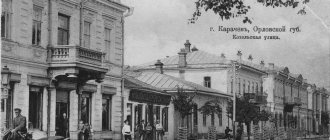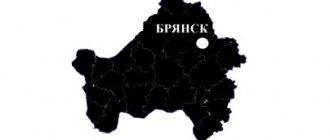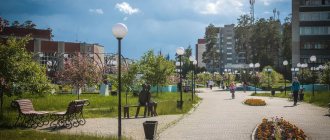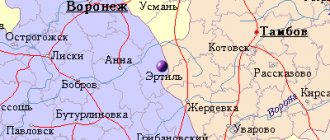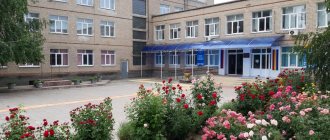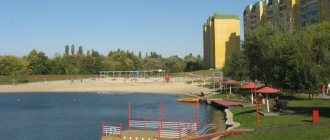Navlya
, an urban-type settlement in Russia, the administrative center of the Navlinsky district of the Bryansk region, within the Bryansk diocese. Located on the Navlya River, 45 km south of Bryansk. Railroad station; The international highway “Ukraine” runs along the southwestern outskirts of the village. Population - 14.2 thousand (2010).
- On the map: Yandex.Map, Google map
According to one version, the name is Navlya
interpreted as an adjective from the ancient Slavic word “nava” - mermaid.
The village arose in 1904 at the station, in connection with the construction of the Moscow-Kievo-Voronezh railway at the end of the 19th century. At the beginning of the century, the Tsar’s brother, Grand Duke Mikhail Romanov, opened a distillery here, which produced raw alcohol for the Brasov princely distillery. In 1914, the Russian-Danish-German society “Julius Judgers” opened a sleeper impregnation plant in Navla.
On May 30, 1924, Navlya became the center of the Navlinskaya volost of the Bezhitsky district of the Bryansk province. On June 17, 1929, the Navlinsky district was formed as part of the Bryansk district of the Western region (since 1937 - in the Oryol region, and since 1944 - in the Bryansk region). During the years of the first five-year plans, a number of factories were built, and social and living infrastructure was developed. On December 4, 1938 it received the status of a workers' village.
During the Great Patriotic War, Navlya and the region became centers of the people's struggle against the Nazi invaders. In July 1941, a fighter battalion was created in the village, and on the eve of the occupation, a partisan detachment was created. The German occupation lasted from October 6, 1941 to September 7, 1943, during which time 22 partisan detachments fought on Navlina soil.
After liberation, Navlya lay in ruins, but the restoration of the economy proceeded quickly. In the 1960s, Navlya turned into one of the well-developed industrial and socio-cultural centers of the Bryansk region: it had 11 enterprises, a new high school, a cultural center, a children's and youth sports school, a cinema, a stadium, and a department store. In 1970 it became an urban village.
Statistics
- 1917 - 117 people
- 1924 - more than a thousand people, 124 houses
- 1938 - approx. 7 thousand people, 1180 houses
Attractions
In Navlya there is a museum of partisan glory, a square of underground partisans, a monument “Wall of Memory” of members of partisan detachments with a bust of the commander of one of them, Pyotr Derevyanko [13], as well as a monument to soldiers of the 10th separate tank brigade of the Bryansk Front (installed on a heavy pedestal tank IS-2). In addition, in the village there is a monument to Lenin, a stele in honor of the liberation of the village, a monument and burial place for the defenders and civilians of Navli on the station square. In the park of culture and recreation named after. Knyazev there is a monument to the defenders of the village in the park named after. Derevianko is a monument to the liquidators of the Chernobyl accident.
Navlya village in 1941-1945
Navlinsky district during the Great Patriotic War of 1941-1945. On June 22, 1941, Germany attacked the Soviet Union, and the Great Patriotic War began. On June 24, 1941, a Resolution of the Council of People's Commissars of the USSR was issued, on the basis of which the Oryol Regional Committee of the All-Union Communist Party (Bolsheviks) and the executive committee of the regional Council of Workers' Deputies decided to form destruction battalions in the regions of the region. The battalions carried out tasks to combat enemy saboteurs, train fighters and commanders to conduct combat operations behind enemy lines. NKVD employees were selected for the positions of commanders of destruction battalions, and party workers and the best representatives of the party and economic activists of the districts were selected for the positions of commissars.
Komsomol underground members
Alexander Vasilyevich Suslin was born in 1908 in Petrograd. In 1918 seven
I moved to Moscow. Alexander was a carver and cutting instructor at the Goznak factory. He was elected secretary of the workshop party organization and headed the propaganda department of the factory party committee. He was an instructor at the Leningrad district committee. He graduated from the Sverdlov Komversary College and received a position as the head of the political department of the Krupskaya state farm in the Navlinsky district. In 1937, he was elected secretary of the district committee and member of the regional committee. When the war began, Suslin headed the Navlinsky underground district committee and district committee. Alexander Vasilyevich was tall. Long black hair combed back, with gray at the temples, a clean-shaven, weathered face, black eyes, a thoughtful look from under high eyebrows. A khaki-colored tunic, from under the collar of which a snow-white collar was visible, black cloth trousers with red piping, simple cowhide hunting boots, a sword belt on the right side, and a revolver in a holster.
Sources:
https://dic.academic.ru/dic.nsf/ruwiki/107871 https://wiki-org.ru/wiki/%D0%9D%D0%B0%D0%B2%D0%BB%D1%8F_( %D0%91%D1%80%D1%8F%D0%BD%D1%81%D0%BA%D0%B0%D1%8F_%D0%BE%D0%B1%D0%BB%D0%B0%D1 %81%D1%82%D1%8C) https://www.br-navlya.ru/
Bryansk region Navlinsky district
Navlinsky municipal district is an administrative unit in the east of the Bryansk region of Russia. The administrative center is the urban-type settlement ► Navlya. The area of the district is 2030 km². The main rivers are Navlya and Revna. The population of the district is 28.2 thousand people, including about 16 thousand living in urban areas. There are 86 settlements in total. The largest of them are Navlya and Altukhovo.
Agriculture, agro-industrial complex, farmers of Navlinsky district.
Dobronravov Agro SPK RYABCHEVSKY .
Peasant farm "Gordeev" Zubovskoe A. Novikov and T. Kirichenko .
► History of Navlinsky district
► Attractions Navlinsky district
Sights of the Navlinsky district of the Bryansk region
Memorable places associated with the Great Patriotic War
Notes
- ↑
Population of the Russian Federation by cities, urban settlements and regions as of January 1, 2010 - ↑
A wall of memory has been opened in Navla. // briansk.ru. Archived from the original on February 12, 2012. Retrieved April 28, 2011.
- Narrow gauge railway of Navlinsky sleeper-impregnated Sergei Bolashenko
Moscow | DSK "Michurinets"| Vnukovo | Forest Town | Kokoshkino | Village of Kryokshino station | Village of the state farm "Krekshino" | Aprelevka | Alabino | Selyatino (urban village) | Selyatino (village) | Rassudovo | Bekasovo | Alexandrovka | Naro-Fominsk | Vorsino | Balabanovo | Obninsk | Shemyakino | Maloyaroslavets | Erdenevo | Goncharovka | Detchino | Jubilee | Tikhonova Pustyn | Kaluga | Vorotynsk | Babynino | Kudrinskaya | Sukhinichi | Duminichi | Palicki | Solonovka | Zikeevo | Sudimir | Berezovsky | Batagovo | Lesnoye | Bryansk | Coupling | Sinezerki | Privolye | Klyukovniki | Navlya | Altuhovo | Kokorevka | Kholmechi | Nerussa (station) | Nerussa | Suzemka |
